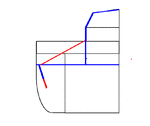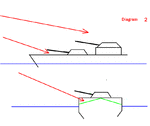Has anyone seen the History channel programs Hunt for the Bismarck?
The show was on today from A&E's "dogfights" series, great animation, especially the Swordfish attack sequences. However.... There are several obvious errors that seem to keep being repeated about the Bismarck
Hunt for the Bismarck
Hunt for the Bismarck DVD
I have also seen "Sink the Bismarck"
Sink the Bismarck + Sink the Bismarck DVD Set
On their blurb about the DVD, they make the same common erroneous claims about Bismarck.
1.) Largest Battleship ever built - Wrong
2.) Most deadly Battleship ever built - Wrong
3.) Biggest guns on a battleship - Wrong
4.) Most "powerful" Battleship at that time - also wrong IMO
So I will see what the opinions are, what is the most powerful battleship? ie. If you were in a battleship for a straight-out duel, in which speed is not a factor, which one would you choose? {both ships are steaming toward each other, intent on mayhem.}
The AA armament is also not a factor, as in 1941 no battleship's AA was proved very effective without fighter CAP: the Bismarck couldn't shoot down any of the attacking Swordfish, the Prince of Wales Repulse only shot down 4 out of 85 attacking Betty/Nell bombers.
I would note that in the final battle, the Bismarck had a damaged rudder was leaking fuel, but her hull was intact, all of her guns equipment were functional. However the supposedly "Most Powerful, Deadly Battleship" Bismarck concentrated her fire on HMS Rodney {Nelson class} but was unable to do any significant damage to the British ship.
Sorry folks, Iowa Yamato are not completed in May 1941....
Stats:
Bismarck 8 x 15" guns, 10.6" - 12.6" armour belt, 3.1 - 4.7" deck armour
HMS Nelson 9 x 16" guns, 13" - 14" armour belt, 5" - 6.75" deck armour
N. Carolina 9 x 16" guns, 7" - 12" armour belt, 4.5" - 5.5" deck armour
Nagato 8 x 16" guns, 7" - 12" armour belt, 4" - 6" deck armour
Littorio 9 x 16" guns, 13.8" armour belt, 3.5" - 6.4" deck armour
Richelieu 8 x 15" guns, 13.6" armour belt, 5.9" - 6.7" deck armour
One other important point, the placement of the main guns.
The Bismarck had 4 twin 15" gun turrets, Nagato 4 twin 16" guns, two forward two aft.
N. Carolina Littorio had 3 triple 16" gun turrets, two forward, one aft.
French British Battleships had all main guns on the foredeck, the Richelieu with 2 quadruple 15" turrets, the HMS Nelson with 3 triple 16" gun turrets, the middle one superfiring over the other two. {This meant that Nelson could fire all guns at any ship in the forward arc, unless it was within 5' deg. of centerline.} When approaching Bismarck, HMS Rodney could fire all 9 main guns, while Bismarck could reply with only 4 of 8 main guns.
thats pretty gay



